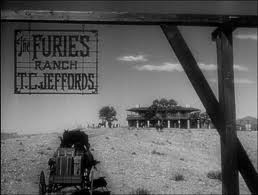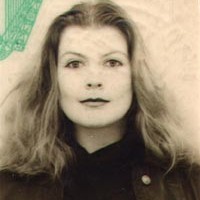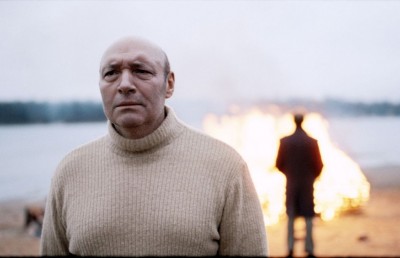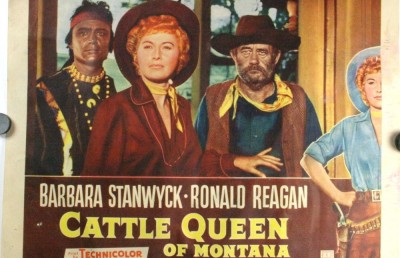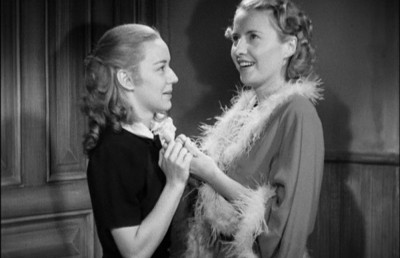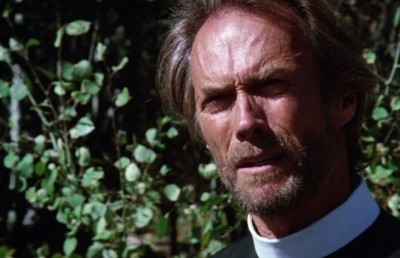Steers, Queers and Pioneers: Barbara Stanwyck’s 1950s Westerns, Part 1: Anthony Mann’s The Furies
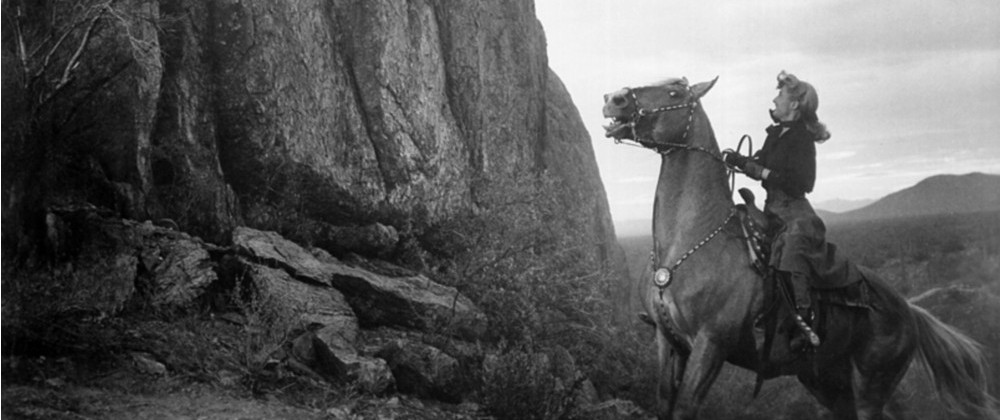
On 28 April 1973 in Oklahoma City, Barbara Stanwyck was inducted into the Hall of Fame of Great Western Performers in the National Cowboy Hall of Fame. Her regular co-star Joel McCrea presented her with the Wrangler Award and a portrait was commissioned for the occasion. It was a tribute in recognition of her services to the cause of the western film genre, in which she had made such a stunning impact over her lengthy career, but especially during the 1950s when she shot seven westerns, and in the late 1960s, when her role as the powerful matriarchal figure, Victoria Barkley, dominated TV screens in The Big Valley. The film western had made a particular space for women in the 1950s: the rhetoric, both narrative and visual, expanded and so it seemed did the genre’s psychological spectrum. However, the representation of women in Westerns has always posed major questions: what do they represent dramatically and ideologically? Are they just adjuncts to the male protagonist? Can they ever carry a film by themselves? (And – can they shoot a gun?) Complicating the issue for our understanding of the issue is the problem presented by the star persona and its interaction with the narrative subtext. Frank Capra, one of Barbara Stanwyck’s greatest collaborators and directors, once said of her that she was “the greatest emotional actress the screen has yet known” and it was with his guidance that her attractive yet somehow discomfiting intensity was scaled back to fit the limits of the film frame convincingly in a number of genres and in a variety of character types.
In the early part of her screen career Stanwyck had non-exclusive contracts with both Warner Bros. and Columbia Pictures and eventually graduated to glamour roles but her most persuasive performance of the era was in Annie Oakley (Stevens, 1935), her first western and a tremendous boost after some dull years at Warners. She gave a great deal of herself to the legendary frontier character, ploughing that fabled performative dedication into the tale of the female cowboy but she also mastered the art of controlling horses and learned how to achieve the affect of gunplay. It would stand to her. Two years later she would earn her first Academy Award nomination for her performance in Stella Dallas (Vidor, 1937). Her most perfect performance for Capra was perhaps in Meet John Doe (1941), which deftly combined her sweetness with a powerful subtlety; but she also excelled in several thrillers and comedies. Her versatility left some directors in awe. However it was partnered with Fred MacMurray in Double Indemnity (Wilder, 1945) where her devastating powers were unleashed in a cynical tale of debasement. Her personal favourite of her films was to follow a year later. My Reputation (Bernhardt, 1946) was a women’s picture, outlining the social difficulties facing a young attractive widow and mother who does not want to conform to expectations. Stanwyck’s own life was taking a turn against the tide as the next decade commenced – returning to the genre in which she had made an impression years earlier – the western. Her look – wide cheekbones framing gimlet eyes; a long, aquiline nose leading to an attractive pout resulting from an untreated overbite which helped her speak with both upper and lower sets of teeth visible if she wanted, lending a vicious sweetness to her disguise, a smile concealing a grimace or vice versa – combined to give the perception of an innocent; but with merely graduated facial movement, Stanwyck could suggest dangerous depths and threatening force. It was the perfect mask with which to take on roles in the most masculine of genres in the decade to come and a wonderful platform for her seemingly boundless expressivity.
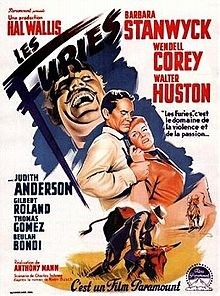
Stuart Kaminsky says that “Genre helps us see the unique properties of individual works by permitting comparison of these works with others of the same basic type.” He continues, “the roots of genre are not solely in the literary tradition but in the fabric of existence itself. “(1977: 12) Ken Dancyger cautions that:
when we speak of structure in genre, implicitly the question devolves to plot or character layer or both, or to what proportion of each is appropriate in each genre. In order to understand structure in a meaningful way, it’s best to link the issue of structure to the dramatic arc of a genre (Dancyger, 2001: 65).
Any screenplay consists of a number of variables or story elements which nonetheless carry the story’s spine: a definite profession for the hero; a recognisable flaw in the hero which is related to that profession or situation; an event which forces the hero to choose between the flaw and an opportunity presented in relationship with same profession/situation; and a fresh approach to this angle, coupled with a sense of dramatic irony arising from the relationship between the major story event or catalyst and the hero’s profession/situation. In any well written screenplay the audience is affected by the hero’s response to the change in their circumstances and we respond to the character’s actions as they attempt to reinstate the status quo which has been disrupted. We might say that, in layman’s terms, what matters, matters, in screen storytelling. The western genre itself is a description of the winning of that part of the United States in a limited period (usually 1865-1890) and therefore the context for its critique usually refers to its specificity as historical representation, the verisimilitude of its reconstruction and the value of the contribution that the re-imagining of the west makes to generic filmmaking. This invariably calls up questions of ideological formation and the material basis for the west itself, a conquest and sovereignty that has frequently been presented as a binary opposition of shifting ideological antinomies as explored by Jim Kitses: Desert and Garden, West and East, uncivilised and civilised, the past and the future, and so forth (Kitses, 1969: 11). A more complex reading involves questions of socio-economic forces. However the interplay with contemporary audiences and therefore the modern also presents a mode of nostalgia, which reflects back upon the time in which the respective films are made and exhibited: in other words, they combine to produce a myth.
Adapted by Charles Schnee from the Niven Busch novel, a freewheeling adaptation of that very mythogenic source, Dostoyevsky’s THE IDIOT, The Furies (1950) was a project nurtured by Anthony Mann. Set in 1870s Mexico, it has a number of pivotal generic archetypes which owe their origins to Greek tragedy in this overwhelming story of patriarchal power, rage, envy, greed and trauma. Busch had earlier earned notoriety as the writer of Howard Hughes’ infamous Duel in the Sun (Vidor, 1946) aka ‘Lust in the Dust,’ so this loose adaptation of a tragedy with Oedipal overtones was of a piece with his earlier avocations. As Blake Lucas puts it, he “…gave his stories a basis in modern psychology and linked them to the great dramas of antiquity, and … he was one of the first to thrive when the post-war western turned to specifically adult subjects” (Lucas in Kitses and Rickman, 1998: 315). Kitses’ reading of Anthony Mann also finds that his “response to the western was not a response to history … but to its archetypal form, the mythic patterns deeply imbedded in the plots and characters of the genre that can shape and structure the action” (58). More than this, Kitses finds that Mann views the family as the repository of “the highest good, the source of all evil.” (61). Thus Busch and Mann’s predilections and interests dovetailed neatly with each other in the form of The Furies.
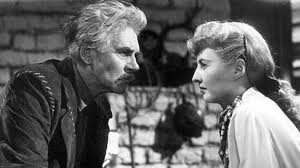
Her father’s daughter: the Stanwyck-Huston face-off
The opening of The Furies commences with a scrolled written introduction, locating us in the Southwest and thereby specifying the importance of the ranch, on the edge of Mexico with the desert at its frontier and the population constantly ebbing at its borders. The ranch itself bears the title name, unlike the book, which refers to the property as Birdfoot and commences with general comments about malign influence. The novel details the breakdown of the father’s marriage with Vance’s mother because of an interracial affair and explains the lack of maternal affection in her childhood. It is clear in the novel that Vance has had an affair with Juan Herrera (Gilbert Roland in the film) but they are just friends from childhood in the screen adaptation, albeit with an extraordinarily powerful sexual attraction and a kiss that frames the beginning and end of their relationship as adults ‘the kiss of a good friend.’ TC’s two-year sojourn away has meant he has missed his wife’s funeral and her bedroom is preserved just as she left it. He offers Vance the ranch on condition that she finds a husband of whom he approves. Thus the film’s setup deviates somewhat from the novel, with Greek tragedy now inscribed into the very earth that it is intended Vance will inherit.
The film was partly shot on location in Arizona and all the interiors were shot at Paramount Studios on Melrose Avenue. It boasts Mann’s usual signature – a formal dynamism within the shot, sculpted from noir-style imagery; quick cutting on action; deep chiaroscuro lighting coupled with complex interior production design; complex low angle shots to emphasis drama both external and internal; and a strong focus on positioning the characters to dominate drama within the frame so that power relations can be visually comprehended. The grammar of the film’s language expresses the film’s internal dramatic co-ordinates and deploys its emotional geography: visually, framing is dominated by the major character in each sequence, regularly cornered by some aspect of architecture, compared with a portrait or squashed by the mountainous backdrop, riding left to right in a formation that goes diagonally down the frame in a compelling drive to shape the forceful forward motion of the storytelling, all punctuated by the booming, overwrought orchestral score.
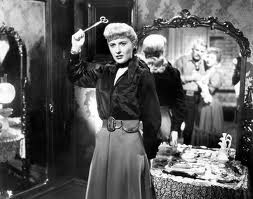
Vance takes aim at Flo with her mother’s scissors
A protagonist (or hero, if indeed the protagonist is heroic) is the driving force of any story. In the Aristotelian formulation, ‘we are what we do.’ “Character,” he states, “gives us qualities, but it is in our actions – what we do – that we are happy or the reverse.” (Aristotle, 1920: 37) Whereas Aristotle prioritises plot in story construction (he calls it the soul of the tragedy), Lew Hunter reminds us that “character and plot must intertwine” (Hunter, 1993: 81-82). And, advises Lajos Egri, “If we wish to know the structure of conflict, we must first know character. But since character is influenced by environment, we must know that too. It might seem that conflict springs spontaneously from one single cause, but this is not true. A complexity of many reasons makes one solitary conflict” (Egri, 1946: 136). In other words it is the gap – or lack – between what the character wants and what the character needs that creates narrative motion. It is the protagonist’s desire that provides the drama’s motor.
Whereas Aristotle’s analysis of drama focuses exclusively on plot and action, it is true to say that what grips an audience is character, a fact that Egri emphasises to expose the structural tenets of dramatic writing:
There must be something to generate tension, something to create complication, without any conscious attempt on the playwright’s part to do so. There must be a force which will unify all parts, a force out of which they will grow as naturally as limbs grow from the body. We think we know what that force is: human character, in all its infinite ramifications and dialectical contradictions (Egri: xvi).
He continues that
…all that is required of a well-constructed premise: character, conflict, and conclusion (Egri, 1946: 8).
Thus we see that the formal structure governing the narrative force of The Furies derives from the desire of Vance (Stanwyck) for Rip Darrow (Wendell Corey, Stanwyck’s co-star in that year’s The File On Thelma Jordan, Siodmak) a man who has a penchant for violence towards her despite his superficial civility; and the wedge that her desire drives between herself and her father, TC (Walter Huston) who wants to maintain full control of The Furies with neither interloper nor squatter. The rancher’s daughter is a stock figure in the western but rarely foregrounded as here. The desire overall in the film – the narrative substance providing the story’s motor – is that of control. This is emphasised one hour or so into the film, when the sequence finally brings out the issues that have now come between Vance and TC: embodied in the figure of an ambitious older woman, Flo Burnett (Judith Anderson), clearly out to get The Furies and TC’s money. Vance states to her brother in the film’s first ten minutes that she never understood her mother/has never let her father best her. This is the narrative rhyme on which the film’s spine is predicated. We further learn that T.C. trades in his own currency, TCs (IOUs); and we learn later in the story that her father needed other women because her mother was a lady. When Flo arrives she has the appearance of a lady but is actually a woman (her open indications of a physical relationship with TC proves that and horrify Vance). When Vance is rejected by Rip for misreading his signals and he agrees to a payoff of $50,000 from TC, TC embraces his daughter with the words “Welcome home!” Thus, Vance’s narrative journey means besting her father on his own terms whilst learning how to be both a lady and a woman, donning the refinements of the former whilst acquiring the business savvy of the latter. It requires sacrifice and a wrath that is written in the ranch’s name, a canny narrative strategy presaging tragedy and vengeance, tied into the earth itself. The Herreras’ standoff takes place in a mediaeval-style citadel high on a rock face from which they regularly push boulders at the enemy, linking the story’s power with mythical characters and accreting the force of the lush visuals. The fact that Vance links with them and leads the charge against her father and his enforcers lends weight to the elemental forces in the drama, punctuated at regular intervals by the bellowing mocking laughter of TC, a classic self-made man and total bully.
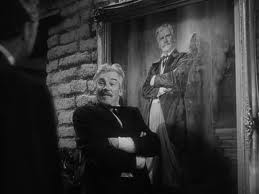
TC imitating his own portrait
Director Anthony Mann said of westerns that “… a woman is always added to the story because without a woman the western wouldn’t work” (Cook in Kitses and Rickman, 1998: 293); on the other hand, Mann’s work is always structured as a spectacle designed to have the man as the desired object and therefore operates as a kind of homoerotic voyeuristic spectacle (Willemen in Kitses and Rickman: 211). Therefore, casting a star as intense as Stanwyck in such an outrageous Oedipal scenario opposite an equally aggressive actor playing her father, was doubly impressive. This was the role that would ease Stanwyck into a new phase in which she could ameliorate her formidable powers, creating a showcase for a dramatic bifurcate acting opportunity – displaying a business acumen and capacity for physical action in which she can easily duke it out with the boys; whilst also donning the garb of a lady in a phase of performative femininity and trading up her father’s IOUs (“my own legal tender!”) so that they rebound on his cattle deal in the most spectacular fashion possible in order to best him after he hangs Juan Herrera. Señora Herrera (Blanche Yurka) has the last laugh however (and literally) when she shoots TC in the back – the final twist in the narrative knife for this terrible old bully. A woman scorned is nothing compared with a mother deprived of her eldest son. Ironically TC has just asked Vance and Rip to name their first-born for him – in this narrative, a life taken is replaced with a life presumed to be given at a later date (another of TC’s TCs). This Oedipal scenario is also predicated on the assumptions of the time: that the masquerade of masculinity must ultimately be sacrificed in a drama of containment in which the female hero is changed into traditional women’s clothes and bears children in a family structure. The assumption here is that she will bear a male child – and repeat the phallic power structure underwriting her own temporary position as heir. Recuperating the feminine by the conventions of the time is the underwriting strategy of even the most radical of western themes.
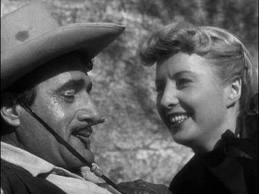
Juan extols “… the kiss of a good friend”
If we specifically refer to its representation of women with regard to the ‘truth’ of women’s experience in the west, the intersection of representation in the western in this pivotal cultural and social era, the 1950s, resonates more than ever. Bazin writes of “the great epic Manicheism which sets the forces of evil over against the knights of the true cause”(Bazin, 1992 :145) and he identifies woman as the force for good. If we apply this reasoning to The Furies, however, we come up with a rather different interpretation For the western is a genre now capable of dispensing to its audience a sense of moral ambiguity. In other words by the early 1950s it has become a more mature entity, distinguished by its adult approach to material and more invested in its own evolution as dramatic form. The code identified by Warshow as that by which the Westerner abides is not confined to male characters, he (or she) openly carries weapons and is disposed to dispensing justice on the open range. Stanwyck’s character here defies Warshow’s concept of the woman as the centre of a peaceable community and civilising influence: she herself is the drama’s principal agent of action, the source of the disruption of the status quo and its reinforcement at the conclusion.
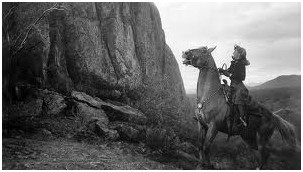
Pounded by boulders at the Herreras’ citadel
Lesbianism
Robert Corber sets out a template by which Lesbianism in its various iterations can be read through performativity, narrative and nuance (Corber, 2011) and it is this idea to which we now turn. The transgressive nature of Stanwyck’s roles in the 1950s occupied a space at a particular cultural moment widely discussed elsewhere: the return to the domestic sphere of a newly empowered female generation following the conclusion of World War II; the emergence of the cult of ‘Momism’; the subversion of the notion of ‘home’ as a triumph of the social instead recognisably the seeding place of newly popular psychiatric ailments; the relativity of femaleness. All of these were aspects of representation which Hollywood struggled to depict throughout this era. The western became the genre which was somehow able to provide powerful roles for women in an acceptable action format whereby violence was permitted in the struggle for self-defence and that of the home or ranch. Breeding wasn’t just confined to women, it was about animal husbandry and money and breeding children, property and land rights and inheritance.
Power is expressed through the vivid dialogue which is multi-layered and expressed in a number of different registers, all an echo of the powerful, charismatic, double meaning that is TC Jeffords himself. When Vance first meets Rip Darrow after he appears uninvited to Clay’s wedding, she takes an immediate fancy to him because her father despises him and she dances him onto the floor. Their conversation has three aspects: business, quipping and then sexualised banter. This focus immediately conveys Vance’s imitative qualities, taking over where her father leaves off: she has learned from his example, and understands that to be a woman in a man’s world she has to emulate masculine qualities – or die like her mother, a memory embalmed in a bedroom left the way it was before she died. TC never came home because he couldn’t cope with anything he owned slipping away. Vance has not reckoned on competition from another, living, breathing woman, however. We understand from Vance’s behavioural habits that she has none of the devious, feminine guile possessed by Flo, the older woman: “I don’t know how to fight her!” Vance tells her brother Clay, who is concerned for his sister’s predicament as the rightful heir to the ranch yet who is apparently doomed to a long trip to Europe and an occasional visit to her own home while Flo makes over their mother’s bedroom.
This scene is not just about plot propulsion, it is about character revelation and it is here that we duly acquire sympathy for Vance – she just doesn’t know how to behave with or to control other women. She needs to learn. Linda Palmer asserts: “Well-crafted supporting characters allow the audience to see a hidden aspect of the leading character, or help to clarify the leading character’s motivation. They can convey exposition in an entertaining way” (Palmer, 1998: 109). In casting any film it is the supporting characters who help us understand how we feel about the protagonist – and here Judith Anderson (who terrorized Joan Fontaine in Rebecca, 1940) terrorizes the audience as much as she does Vance. It might be worth remembering that, whilst not widely known at the time, Anderson was in fact, along with Stanwyck, rumoured to be Lesbian, and therefore she was, as a character actor, regularly placed in roles which required (as Robert Corber reminds us, and according to Hollywood’s own contemporary perception of normative sexuality) a certain frisson of fear and unknowability. She excels as Flo, whom Vance then scars with a thrown scissors, damaging her very particular type of femininity, leaving her with a gash on her cheek and a permanently weeping left eye. Anderson had famously played Medea on Broadway in the recent past (and won a Tony for her performance), feeding into Busch’s ideas regarding the incorporation of Greek tragedy in psychological tales of inheritance, passion and greed. It also formed a basis for Mann’s own understanding of how western drama should play out. That sense of theatricality is also evoked with the staircase on which so much intrafamilial anxiety is staged: it is the platform on which Vance watches her father play around with Flo; where she has it out with him over her own relationships as the rain pounds the window pane on the half-landing; where she watches her father’s homecoming before he hands her a desultory set of old-lady pearls in advance of her true gift of real jewellery. It is the vantage point from which Vance assesses her situation as the world falls apart around her. These staircase scenes are a replication of the many scenes of mis/recognition that populate the woman’s film. Doane says it is this space “which articulates the connection between the familiar and the unfamiliar, or between neurosis and psychosis” (Mary Ann Doane, 1987: 135-6).
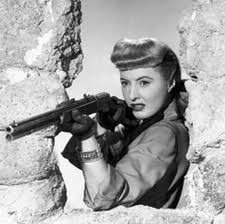
Sixguns and southwest society
The Greek furies of course punished the most egregious crimes of all – matricide and patricide. In the film Vance clearly holds her father responsible for her mother’s death – even if she never understood her. Her action against her ‘replacement’ mother in the form of Flo, the ‘woman’ who appears to be a ‘lady,’ is then a more straightforwardly readable act of violence. The theme in the title is also inscribed in Vance’s protective attitude towards the Herreras, as an ethical stance or even an idealistic position, which otherwise would make no sense in the context of keeping her property one of a piece and regaining total control. It also explains Vance’s vigilance towards her father’s vicious character: in her eyes he has murdered both her mother and her lover, a variation on the story of Orestes, who is at the heart of the myth. The Furies is a story of retribution for crimes against the natural order. Vance is therefore an angel of vengeance.
In a change to the trajectory of the classic realist text, the woman’s contested role and her desire does not result in the formation of the heterosexual couple, which is usually the man’s decision, rather its destruction, when Juan, her natural companion, her equal and at the same time her adversary, is hanged at her father’s insistence. Thus the oedipal scenario at play results in the triumph of male desire over female desire and the woman’s agency is dissipated, resulting in what Laura Mulvey calls the splitting of the hero: “Here two functions emerge, one celebrating integration into society through marriage, the other celebrating resistance to social demands and responsibilities, above all those of marriage and family, the sphere represented by woman” (Mulvey, 1981, unpaginated). Neither character is hero or villain, both are. The ‘doubling’ effect therefore is irrelevant since both father and daughter could be said to be both figures, at various junctures in the narrative. Neither could be said to personify or even to uphold the law, either. “The female spectator’s fantasy of masculinization is always to some extent at cross purposes with itself, restless in its transvestite clothes.” Mulvey may be writing about quite a different film, The Man Who Shot Liberty Valance (Ford, 1962); but The Furies similarly boasts protagonists whose paths do not easily cross and in which the role-playing connotes questions of queerness, inappropriate sexual desires and transgression. This is a family where the sole child is an adult woman who is resolutely unmarried and has what might be termed male ambitions. She appropriates the outward affectations of maleness in order to fit in and express her ambitions, which are traditionally male and explained in the novel at least by her mother’s distance. She dresses appropriately for her tasks. She simultaneously desires and refuses marriage because it is refused her through Rip’s more significant desire for the Darrow Strip and therefore she resists integration into a world of biological expectation, at least at first. She dons women’s garb and wiles in order to re-establish her actual self which has been camouflaged with too much maleness and not enough female intuition: she rises to the top in business because she cultivates a banker’s wife and learns how to trade her father’s IOUs: $140,000 of nothing. Her very essence symbolises transgression. It is a portrayal which defies easy categorisation and is Stanwyck’s first great western role in which the narrative spine established early in the dialogue forces her to accommodate her female and male selves in order to assert her personality and her control over the other characters, the property and the forward thrust of the narrative arc.
This is a drama of individuation, whether female or male. Sexuality and the representation of gender identity are given great force in Stanwyck’s expressive performance style: she is perceptibly ambiguous if not actually androgynous, forcibly integrating aspects of masculinity into her screen persona as well as being clearly attractive as a woman to men. It is this embodiment of sexual contradiction that allows her roles to be read as a seat of cultural conflict and also as potentially queer representation. The family melodrama is an affective mode of genericity that underwrites all cinema. The impossibility of closure makes the plight of the film family one of eternal compromise. The traditional overloading of paternal authority, the gender confusion of its progeny and the siphoning off of inappropriate rebellion into sexually unsatisfying marriage, all are elements which underlie the construction of the cinematic nuclear unit in melodrama. Its overwhelming failure to provide anything other than the ‘emergency exit’ ending has compromised its impact as narrative, although its importance as a fundamental mode of American cinema is not diminished. Mann’s own interest in Classical tragedy and in particular the incident of usurpation is fully declared here (Kitses: 62).
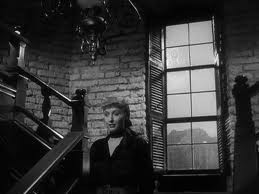
Another reality dawns descending the staircase
The masquerade performed by the female in adopting a male form of dress and attitude destabilises reading of the feminine. It not only confuses the masculinisation of the look (in both senses), it effects a defamiliarisation of female representation. Modes of address and generic specificity – there are ‘male’ and ‘female’ films, as well as the ‘woman’s film’ which addresses the female spectator through female themes, some authors claim, albeit there is also the possibility of multi-address films – can convey a new rhetoric (Gledhill, 2008). These questions devolve upon arguments presuming upon the alignment of gender with genre – the idea that action is a male interest, ‘women’s films’ a purely female preserve, and that genre itself depends on the presentation of gendered bodies. For Bazin, “to engender respect for women more was needed than the fear of a risk as trifling as the loss of one’s life, namely the positive power of a myth. The myth of the western illustrates, and both initiates and confirms woman in her role as vestal of the social virtues, of which this chaotic world is so greatly in need” (Bazin, ibid.).
